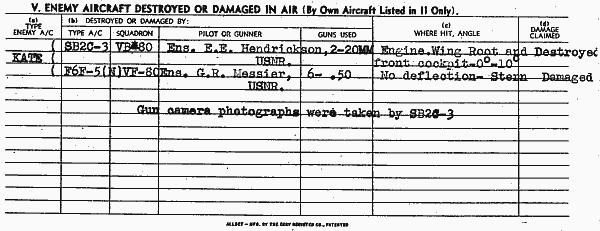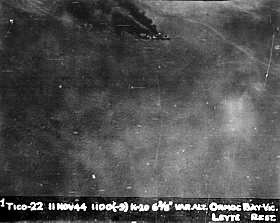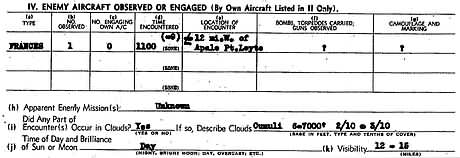Menu | ||||||||||||
|
| |||||||||||
| ||||||||||||
![]()
|
Action | ||||||||||||
|
| |||||||||||
| ||||||||||||
![]()
Welcome To the CIC | |||||
| On 11 November 1944, In Conjunction with other Air Groups of TG 38.3, approach was made by CVG-80 at 13,000', from the North across Samar, down to Carigar Bay, across N.W, Leyte to Ormac Bay.  Strike on Enemy Convoy - 11 November 1944
 The Japanese convoy previously reported by search planes as headed South between North Leyte and Cebu, was seen steaming on course 090 between Ponson Is. & Apale Point on Leyte, entering Ormac Bay. The convoy was already under attacks when Air Group Eighty approached & consisted at that time of 4 merchant shipd variously identified as FTB's and TB's, DD, 1 DD/DE, and 2 DE.  TACTICAL AND OPERATIONAL DATA VF-80: Over Ormac, The Group split, with 2 divisions of 8 VF attacking from the N.E. Other attacked from the East and, circling from S.W. No air opposition whatsoever was encountered by VF-80. They therefore went in on rocket and strafing attacks with other planes. VF-80 concentrated their rocket attack on the leading Escort ship, the DD (Target #1), and strafed both it & the 2 DE's (Target #1 & #5), 8 VF also attacked the DD or DE (Target #4) at the rear of the convoy. As this Group was making its approach, the 2nd merchant ship in the column (Target "B"), blew up in a violent explosion & promptly sank, due to hits scored by previous attacks, presumably by the ESSEX Air Group. The VF-80 attack on the Escort ships, combined with attacks by other squadrons resulted in seriously damaging the DD (Target #1) with 8 confirmed 5" rocket hits and strafing. When left however, it was still under way. The DE's & the DD/DE, (Targets 2,3, &4) were very seriously damaged & when last seen were dead in the water & burning furiously & in a sinking condition. The merchant ships were (all four) either sunk or in a sinking condition when last seen by VF pilots. Target "B" had blown up; "C" was dead in the water, burning, and down by the stern; "A" was also dead in the water, burning, & was reported as very low in the water (only a few feet of freeboard); Target "D" was burning badly & appeared to be headed for the beach in a very seriously damaged condition (some pilots reported here dead in the water when last seen. The foregoing is confirmed by ComCVG-80, who, with his division returned to the target area for a second attack with rockets after completion of the dive bombing and torpedo attacks by VB & VT-80 and after most of the group had departed for the rendezvous point.  Flight Data - 11 November 1944 During closing run Ens. Hendrickson lobbed 4 short bursts , and enemy plane immediately began a series of side to side skids. When Hendrickson was nearly in range, his VF wing man (Ens. Messier) slowly passed under him. and a little to starboard and got in 4 good bursts and pulled away to starboard. On Ens. Messier's last burst, Hendrickson saw a puff of smoke come from the enemy plane. Hendrickson opened fire at about 1000', 0o to 10o deflection, and hit the plane in the engine wing root and cockpit sections, possibly killing the pilot. The plane then burst into flames and rolled, hitting it's starboard wing on the water, and then disentegrating. Bits of the airplane and a bloodstained streamed parachute were seen on the surface. Ens. Hendrickson states possibility that enemy fired small calibre free guns at him during closing run. Gun camera film confirms plane in flames and out of control prior to Hendrickson's breakaway. The above narrative and ID as KATE is confirmed by Ens. Hendrickson's combat air crew man, Bunting, J.T., ARM 2/c  One enemy a/c was seen in the rendezvous area, 10 mi. W. of the Target convoy at about 6000'. It was reported as 2-engine, possible a FRANCES. It escaped into a cloud as soon as LT. Fleming's division turned toward it. Lt. Woodward reported seeing what appeared to be a couple of seaplanes in the strait between Leyte & Gumalae Is. (11o-00' N, 124o -25' E). He is not sure and was unable to investigate. Lt. Cmdr. Keith reported seeing many friendly a/c on the Tacloban Strips, line up along both sides of both strips. The altitude from which they were seen prevented identification but there were both large and small planes. Friendly P47, P38, & B24 were observed in the air in the area over Leyte & a B24 was seen near the rendezvous area.
TACTICAL AND OPERATIONAL DATA VF-80: No casualties were suffered by VF-80 Pilots reports on the type of ships varied, but the general consensus was that the ships were large 54-7000 tons & that they were FB or TB-type, "B", which exploded was not identified. The ships' evasive maneuvers were erratic in zig-zags & circles. The rear DD/DE, target #4 was smoking heavily from its stack. AA from the ships was meager to moderate. The worst, most accurate and most persist ant came from the DD (target #1). AA from other ships quieted down after the attack got underway. The only damage received by VF-80 was 1-20MM shell which passed through the elevator of 1 plane, doing negligible damage. It did not explode, going through the fabric. The squadron commander, VF-80 considers that the number of a/c in the air at once, the coordination of attacks was good. He emphatically recommends that, on future strikes of such a nature against merchant shipping where little or no opposition is anticipated, at least half of the VF, be loaded with 1-500# bomb---distance to target permitting.   |
| |||
| |||||

